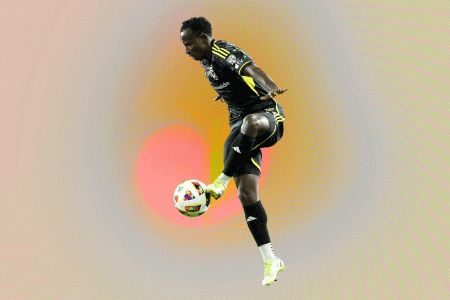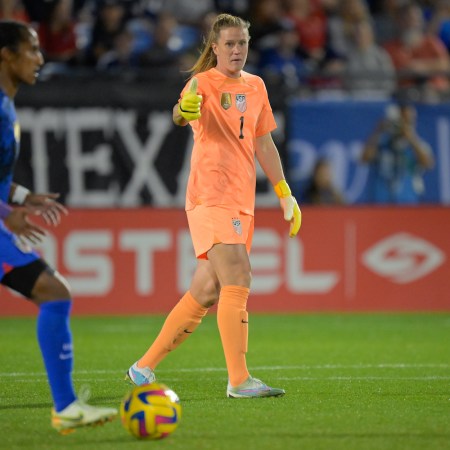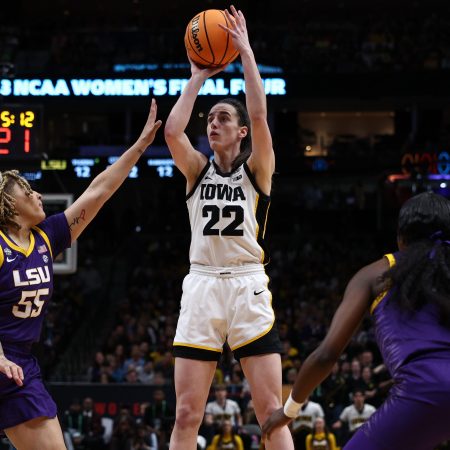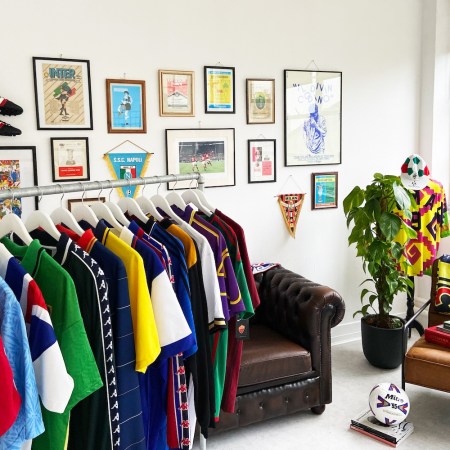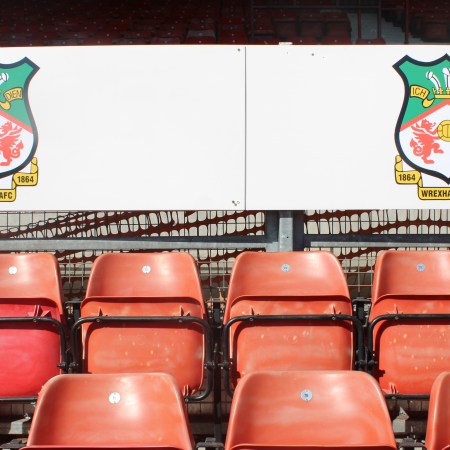Perhaps it’s the one-of-a-kind odor pervading PATH trains in New Jersey that compels kindness in strangers, a reminder that, when it comes to public transit, we’re all in it together. But when my collective of cars unexpectedly reached its last stop one station sooner than I required and all its occupants who looked as though they were also headed to Harrison exited the system entirely, I approached Daniel for directions there.
“You going to the game?” he asked.
I said I was and, sensing my confusion, he explained: “There’s another train coming, but nobody wants to wait 20 minutes for it. Just hop in the Uber I ordered.”
Around 30 years old, Daniel limped to the car, explaining he’d recently blown out his Achilles tendon playing rec-league soccer. Like me, he was a big fan of the sport. I asked him if it was his first time taking in a Gotham FC match. Also like me, it was.
The clouds that relentlessly depressed the New York metropolitan area seemingly since New Year’s finally broke on Sunday, April 14, just in time for Gotham FC to properly honor its National Women’s Soccer League championship of last season. In a ceremony before the team’s home opener for 2024, smokestacks erupted above fresh signage at the end of an overhang acknowledging the title win. The crowd of 8,573 — a team record for home openers — burst into cheers and applause.
In the Uber on our way to Red Bull Arena, which is also home to the eponymous Major League Soccer franchise, Daniel expressed a sentiment that I imagine other American male soccer heads may harbor toward the NWSL as a whole. “I’m hoping the quality is maybe a bit better than MLS,” he said.
As much as I love that league, in more ways than one there’s actually no comparison.
Relative to other men’s soccer club leagues around the world, the MLS value proposition is packaged around its ability to entertain and its competitiveness, spurred by an economic system that generates deep parity. The league is not exactly known for a staggeringly high standard of play, however. Some of the world’s top soccer stars have joined the league’s ranks, most notably Lionel Messi, the greatest player in the history of the sport, who’s currently donning Inter Miami’s black and pink polyester threads. But all those icons from abroad — Messi, Gareth Bale, Thierry Henry, Zlatan Ibrahimović and others — moved to MLS in the waning days of their respective time as pros. Prime seasons for them were spent elsewhere, most often in Europe, playing with the rest of the world’s best in the finest club leagues for men, including Spain’s La Liga, Italy’s Serie A and England’s Premier League.
On the relatively rare occasions when the U.S. produced a soccer player who could compete side-by-side with those magnificent athletes, they went ahead and did so, earning the highest salaries possible in foreign lands. For American soccer players like Christian Pulisic, who was destined for greatness, a career in MLS was probably never even a consideration. And despite the league’s remarkable growth over the past decade or so — in terms of revenue and even, to an extent, quality of play — its best young athletes still perceive MLS as something of a developmental league. Aidan Morris, the standout midfielder of MLS Cup champions the Columbus Crew, for example, has openly discussed his ambition to play professionally in Europe.
That’s not the trend over in the NWSL, though. Its clubs are not only keeping American-born female soccer talent stateside — where many of them have earned a stockpile of medals and trophies by dominating global competitions for years as part of the U.S. Women’s National Team — they’re also importing some of the best players from outside our borders. Arguably no NWSL club has better positioned itself as a potential powerhouse in this way than Gotham FC.

After winning its first NWSL championship, this past offseason Gotham FC promptly signed four prized free agent players who’d all logged time with the USWNT: Crystal Dunn, Rose Lavelle, Emily Sonnett and Tierna Davidson. The moves inspired many soccer pundits, both in the U.S. and overseas, to label Gotham FC’s squad a potential “super team.” Whether or not that moniker sticks through sustained title-winning success over a period of years remains to be seen. But the fact that Gotham FC has even been able to approach team building this way is a testament to the blossoming popularity of women’s soccer in the U.S. — and even women’s sports, writ large.
It’s widely believed that the unprecedented success of the USWNT, which, among other accolades, saw the red, white and blue capture three World Cups and three Olympic gold medals between 1999 and 2019, has been vital to the surge in women’s soccer fan interest. When consumers show up for anything, investors aren’t far behind, and a snowball effect has been in full swing for some time now. Though there had been two previous attempts to build a sustainable women’s club soccer league in the U.S. — the Women’s Professional Soccer league and the Women’s United Soccer Association — the NWSL formed in 2012 and quickly partnered with a little company called Nike, giving it a revenue stream the defunct leagues never enjoyed. The fact that a handful of NWSL teams are also owned by MLS franchises has helped ensure a greater degree of economic strength.
As the USWNT continued to win World Cups in 2015 and 2019, women’s soccer fandom expanded further, with an increasing number of eyes fixed on NWSL matches in the intervening years between the monolithic global tournament. More sponsors showed up and NWSL broadcast partnerships were solidified, culminating in this season’s four-year, $240 million pact with ESPN. League records in fan attendance, home viewership, sponsorship revenue and team valuations are broken on a regular basis.
“The important thing to emphasize with the NWSL is not even just the fact that it’s exploding, that it has all this potential; it’s that it’s here to stay,” says Tamerra Griffin, a journalist who’s covered women’s soccer for ESPN and The Athletic. “That’s something that we were not ever really able to say with certainty about the previous two women’s professional leagues in the U.S. The fact that we’re more than a decade into the NWSL’s existence and it’s expanding at a pretty rapid pace, especially in these last couple of years, is obviously a huge sign of growth. You can’t even say that for the WNBA.”
Women getting an increasingly larger slice of the sports revenue pie was never going to be easy, though. Griffin says that women’s sports are an “inherently agitating endeavor, because you would be hard-pressed to find any culture in the world in which women are encouraged to, or expected to, display their physical strength.” Considering this outlook, she says “the idea of being a girl and running out to go kick a soccer ball is in itself considered an act of protest.”
Chants, Cheers and Beers With the Most Powerful Fans in Sports
We embedded with the Columbus Crew superfans known as The Nordecke for one wild weekend.There was the much-publicized lawsuit the USWNT filed against the U.S. Soccer Federation that demanded equal pay to members of the national men’s team — which they weren’t receiving despite generating greater financial returns. After a six-year struggle for the USWNT, the dispute was settled in 2022, with a guarantee that members of the women’s side would be compensated the same amount as those on the men’s.
Griffin believes this battle not only benefited women’s soccer players in the U.S., but those around the world — and, in turn, the entire sport. “Once players started to understand that they actually had a right to demand better treatment, to demand more parity in the ways that these [global soccer] federations are investing in men’s and women’s teams, they were able to professionalize themselves,” she says. “It’s only a matter of time before other people are going to want the same thing because these are competitors that we’re talking about at the end of the day. They want to win, and they want to make money.”
With the spirit of competition compelling them, compounded with greater outside support of their athletic improvement, women’s soccer players everywhere simply got better.
But then came the large-scale sexual abuse scandal that rocked the NWSL over a period of three years, beginning in 2021. It involved a number of male coaches, as well as female team leaders and players. League executives lost their jobs, including the commissioner, Lisa Baird, who resigned; teams were fined; and some coaches were banned for life. As Forbes noted, it was the kind of controversy that could have been “damaging to a young league [with] something to prove in the public’s eye.”
The episode did lead to positive change, after critics from within the league, namely players and the head of the NWSL Players Association, cited systemic problems of toxicity that bred the safety issues. The NWSL’s front office pledged to enact policies that would ignite a culture change; and then, in January 2022, the league and the Players Association settled on terms for a collective bargaining agreement, a first for the enterprise. Among many other new benefits, the contract raised the players’ minimum salary a whopping 60%, which was an important win for the athletes because, in light of the scandal, some of them cited poor pay as a reason their peers felt powerless against abusers.
“Players drove every decision in this process,” Meghann Burke, NWSLPA executive director, said upon the CBA signing. “[T]hese players stood strong and stood together, right up to the moment of ratification. This is a historic moment not only for our sport and our League, but for all working people who stand up and stand together.”

Hardly sounding like a defeated party after dozens of negotiation sessions, even the NWSL’s interim CEO at the time, Marla Messing, said that the CBA was rife with “deserved advancements” for players.
Yael Averbuch West, Gotham FC’s general manager and head of soccer operations, tells InsideHook that the CBA also laid out the ways in which the NWSL would function for years going forward. Given the previous failings of American women’s soccer leagues, this was a crucial turning point.
“From that moment on, everybody started to strategize and really invest in what the future could look like in a different way than had been done in the past,” Averbuch West says. “There has been a change in how sponsors are seeing this and how people are seeing this, that it’s truly an opportunity for investment.”
It’s part of what attracted Carolyn Tisch Blodgett to the club. A new minority owner and “strategic investor” in Gotham FC, Tisch Blodgett is the founder and CEO of Next 3, a venture capital firm focused on sports backed by New York Giants co-owners Laurie, Jonathan and Steve Tisch. Prior to her arrival in the ownership group, Gotham FC already boasted a high-profile group of investors that included athletes Eli Manning, Kevin Durant, Sue Bird and Carli Lloyd.
“When we examined where the next wave of growth in sports would be, so many signs pointed to women’s soccer and the NWSL in particular,” Tisch Blodgett tells InsideHook. “After meeting with several teams, we were impressed by what Gotham FC had built thus far and saw tremendous potential for future success. As third-generation New Yorkers, the opportunity to help grow a sports franchise in our own backyard was a perfect fit.”
She says the team’s marketing efforts focus on three key areas: “enhancing the fan experience to complement our premier on-field product, building our players’ profiles and growing the fan community.”
“We recognize that many people become Gotham FC fans not just to watch great soccer, but because they’re joining a community where they are included and where they belong,” she adds. “They are becoming a part of something bigger.”
When we think of true global sports brands, there are no women’s teams on the list. We want to change that.
Carolyn Tisch Blodgett, Gotham FC Minority Owner
These heavy financial swings are being taken across the NWSL and are quickly paying off, as team valuations skyrocket into nine figures. With greater investment and a more fine-tuned approach to the broadcasting and marketing of the league, Averbuch West says it is now positioned to better showcase its top-tier players. She notes that some of the best players in the world participated in the earlier American women’s soccer leagues, but now they’ll be adequately compensated, not having to work extra jobs that take time away from their athletic development. They’re also playing on well-kept pitches in more impressive stadiums, and being better taken care of from a sports-science standpoint.
Furthermore, the recently signed CBA introduced free agency to the NWSL, which will help lift players’ salaries and give them greater command over their professional destinies.
“That movement is giving teams and players such a greater opportunity to really build in ways that I don’t really think the NWSL has been able to do before,” says Griffin. “As a tangent, I think a lot about the importance of having a club identity and how difficult it is to [generate one] when so much feels up in the air, in terms of which players you might get. There’s a whole separate conversation to be had about the draft and the efficacy of that, but the CBA and free agency is a huge factor in keeping this league attractive to players.”

Such outcomes mean that the best American women’s soccer players are perhaps more inclined to compete in the NWSL than elsewhere. Though much of their reasoning centered around the pandemic’s impact on NWSL scheduling, when a number of USWNT members leapt the Atlantic to play in Europe, concerned pundits wondered what that meant for the future of the NWSL. The way Gotham FC are operating, this doesn’t seem like a big worry today.
“Definitely, there is a real transfer market for players; there’s real competition around the world for top players now,” says Averbuch West. “But I think we’re making good strides and setting ourselves apart.”
In addition to the investments made around the league, she also points to the highly competitive nature of the NWSL as a selling point. Like in MLS, the NWSL has structured its economic system to promote parity, primarily through the institution of a salary cap. Some critics of this approach say spending limitations prevent any team from becoming great and, thus, more attractive to consumers. But Averbuch West says the evenness in the playing field is a plus. Any team in the league can win any given match, so every game seems to matter, she says, at a level that almost feels like a championship final.
The Gotham FC front office is also making a habit of importing strong players, still in their prime, from abroad. The club recently signed German-born goalkeeper Ann-Katrin Berger, who made five starts this season for Chelsea F.C. Women, a top club in the Women’s Super League of England — which is also experiencing massive growth. And scoring a goal for Gotham FC during the team’s home opener I attended was Esther González; prior to netting the title-winning goal for the club last year, the 31-year-old played for Real Madrid in Spain’s top-flight women’s club league, Liga F. She also won the World Cup in 2023 as captain of the Spanish National Team, a monumental moment that was marred by a kiss delivered without consent to player Jennifer Hermoso by Spanish soccer federation president Luis Rubiales.
Griffin says that players from outside the U.S. have expressed to her that the style of play in the NWSL is “extremely athletic, extremely direct and extremely physical,” something they not only enjoy, but covet. “A player who wants to be the best, they need, they’re craving that exposure to various styles of play,” she says. “That’s a lot of the draw for international players.”
What we stand for as the top women’s sports club in the world is promoting, highlighting phenomenal women at what they do, and allowing those women to break barriers.
Yael Averbuch West, Gotham FC gM and head of soccer operations
Arguably, the NWSL is winning the global competition for talent, but European leagues, particularly the Women’s Super League in England are, at the very least, gaining ground. (Two morsels of proof: the USWNT captain, Lindsey Horan, is playing her club games in France these days; and while Gotham FC signed and retained a number of Horan’s teammates, it did lose USWNT midfielder Kristie Mewis to the English squad West Ham United F.C. Women in the offseason.) Last August, The Guardian went so far as to claim that the European leagues were “overtaking” the NWSL. Though the paper framed that development as a positive for women’s soccer, Daniel Kelly, clinical professor at the NYU Preston Robert Tisch Institute for Global Sport, disagrees with the article’s claim. To support its point, The Guardian wrote that in the last World Cup final there were zero NWSL players on the rosters of the two finalists, Spain and England. Only three NWSL players were rostered on teams that made the semifinals and just two more saw the quarterfinals. “That metric was a bit off,” says Kelly. In addition to the fact that Spain’s captain, González, defected to Gotham FC shortly after the article was written, Kelly points out that “if the U.S. and Canada make it further, like they were supposed to as favorites and didn’t get upset, that argument becomes moot.”
Both the U.S. and Canadian women’s national teams bowed out in brutal fashion, failing to win tightly contested games that served as testaments to the improved level of play in women’s soccer globally — again, a good thing for the sport. “Rivalries tell stories, and as England and Spain advance in their style of play, and they win championships, when the U.S. team competes against them, the storyline is a lot more compelling,” Kelly says. “When the U.S. women’s team was dominating, [wins] became a foregone conclusion, and that did not lend itself to really popularizing the fact that we’re seeing the best and the most high-quality product here.”
Kelly adds that Sophia Smith, a 23-year-old forward who in his mind is the USWNT’s most outstanding player, just re-signed with the NWSL’s Portland Thorns, fixing her signature to the most lucrative contract in the history of the league based on annual value. This was a key maneuver for the league because, Kelly says, it kept a top American player stateside, while she also remained in a relatively small market, maintaining the league’s stark competitive balance.
Still, Averbuch West says the selling of quality players, U.S.-born or otherwise, to teams abroad should be part of a sustainable NWSL club’s business plan. “The next evolution for NWSL is also to develop young talent that is either going to play for individual first teams or elsewhere in the world,” she says. “It doesn’t need to be an either/or, but certainly I’m very proud of what the NWSL is becoming and what Gotham FC is becoming in the sense that we are a destination for [talent]. When players look from around the world where they want to advance their careers, they’re going to look and Gotham FC might be on their list, and we’re really honored by that.”
What We Learned From the Fittest Teams in Major League Soccer
The fitness experts behind the Columbus Crew and the LA Galaxy share the wellness pillars they follow above all othersBeing part of such an estimable organization that does not rest on its laurels, and in which ownership believes enough to continuously sign larger and larger checks for personnel, facilities, marketing, as well as other growth and sustainability musts, is infectious. After the Gotham FC home opener, I asked the team’s head coach, Juan Carlos Amorós, who’s successfully managed women’s soccer teams in Spain and England, about the pride he feels being part of an organization that ownership earnestly values. “That was one of the reasons I came,” he said. “It’s a very enjoyable place to work. I think when we are working in organizations where there is a disconnection between different departments and different people, that obviously doesn’t make success. But what ownership is doing is they are facilitating everybody to do our jobs the best we can. We are still growing, because that’s where we are, but we are going in the right direction.”
“Ownership has been amazing,” said Gotham FC midfielder Yazmeen Ryan, a holdover from last year’s championship team, post-game. “They’re working very hard to make sure that we are seen and that we are one of the best clubs in the world. It’s only the beginning for us, and so I’m excited about what we can do going forward when we’ve already done so much in the short amount of time we’ve had together.”
“You see it on the men’s side: big teams want to bring in the best talent and make it the most competitive environment [within the club],” added forward Katie Stengel, who before joining Gotham FC last season played with Liverpool F.C. Women in the English Women’s Super League. “After our success last year, it was easier to attract more talent, and I think our ownership has done a really good job…. You [always] have to be on, and hopefully we bring more out of each other and make each other better.”
It doesn’t hurt that Gotham FC is the NWSL club catering to the largest media market in the country, a place with more than its fair share of perks.
“You don’t need to sell New York to people,” said Lynn Williams, a forward for Gotham FC and a seven-year veteran of the USWNT. “The vibe of the city is awesome.”
But there’s a whole other inescapable and critical cause that comes with building a sustainable women’s soccer club and league, as well as an entire industry around elite women’s sports, which is expected to reach a billion-dollar revenue mark in the U.S. this year for the first time. “[T]his is bigger than just an investment for us, it’s about joining a movement to quite literally help shape the future of sports,” says Tisch Blodgett. “When we think of true global sports brands, there are no women’s teams on the list. We want to change that.”
“Our fans in general are supportive because they enjoy watching Gotham play, but also really like and appreciate what we stand for,” Averbuch West says. “And what we stand for as the top women’s sports club in the world is promoting, highlighting phenomenal women at what they do, and allowing those women to break barriers.”

Griffin, the women’s soccer writer, certainly supports the positive social impact the sport’s development continues to have, but she is also hopeful for a future where topics like equal rights don’t have to underscore a female athlete’s performance every single time they take to a field. “It’s all about giving athletes the full space to express…who they are as people without having to take on these kind of martyristic roles if that’s not who they are,” she says.
There appears to be so much growth opportunity for professional women’s soccer in this country that organizers of a second top-flight league, the USL Super League, have announced a fall 2024 launch — an unthinkable reality earlier this century when multiple women’s soccer leagues were folding. How this came to pass has involved a countless number of forward-thinking movers and shakers, many of whom have deep pockets. There’s also the advent of streaming, which has provided more channels for sports content and helped give women’s soccer greater exposure, as well as changes in attitudes toward female athletes and women’s sports. Ultimately, though, all of this development of women’s soccer comes down to the generation of fan interest.
“The bottom line is now there’s a demand; the demand is there that wasn’t there before,” says Daniel Kelly, the NYU sports business professor. “There’s always a demand spike during the World Cup and during the Olympics, and then there’s an amazing drop-off. The key is: how do we keep the demand high?”
All signs point in a positive direction for women’s soccer. A small part of why I write this with confidence has to do with another conversation I had, about 15 years ago, with another male soccer fan. Back then I was a regular at a sports bar in Queens, New York, where I befriended a middle-aged Brit named Nick, who sometimes proselytized about the game he called football. Not a fan at the time, but curious about soccer because of its wide international appeal, I asked him why the sport had never completely caught on in the United States, despite numerous attempts to make it a thing here.
“Because Americans aren’t exposed to the best version of the product,” he told me. “If American sports fans got to watch the European leagues, then they would see how great the sport is and begin to enjoy it.”
He was absolutely right. In the time since, streaming has become ubiquitous, allowing people in the U.S. to more easily consume the best soccer the world has to offer, helping boost the sport’s popularity.
However, the conversation between Nick and me had defaulted to the men’s side of the game. Americans might not have the world’s best male soccer players putting in godlike 90-minute performances for clubs located within our 50 states, but all the data — and my own two eyes — tell me we have the best women players doing so.
In that Gotham FC game, against the Kansas City Current, who as of this writing sit atop the NWSL standings, I saw two well-organized teams play a match that at times was both physical, with a number of bone-crunching tackles, and wide-open, as wingers and forwards of both teams pressed quickly up and down the pitch. The two goals were terrific: a fast-developing counterattack that turned into a breakaway for perhaps the quickest human being I’ve ever seen on a field — the Current’s Temwa Chawinga, from Malawi — and a flawless far-post header by Gotham’s Esther González, from a booming corner kick that cleared about three-quarters of the penalty area.
For as good as soccer is on television, it’s so much more satisfying in person. Though I can’t speak for Daniel, I was blown away.
The Charge will help you move better, think clearer and stay in the game longer. Subscribe to our wellness newsletter today.


